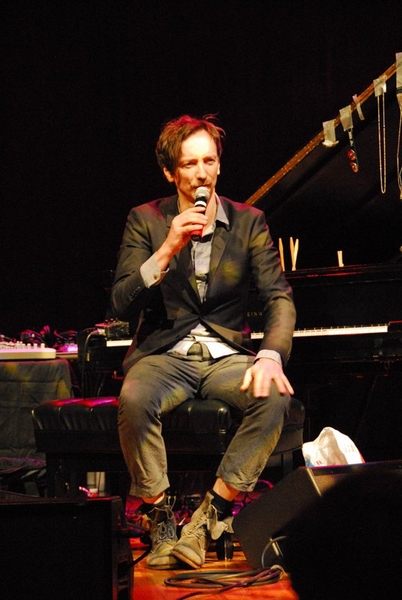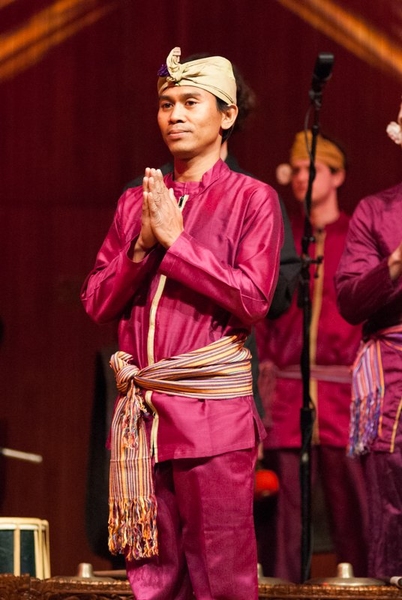It was likely the first time Senegalese sabar drums, a cello, a didgeridoo, an accordion, a piano and panpipes made from test tubes all occupied one stage together. From Balinese gamelan to original glass instruments, the CAST (Center for Art, Science & Technology) Marathon concert presented five full hours of genre-bending new music on April 5 in MIT's Kresge Auditorium. A follow-up to 2011's FAST Forward Marathon concert, the concert celebrated the convergence of art and technology — from simple percussive acts to the most sophisticated gestural controls — and showcased the many creative tools and techniques used by artists from MIT and beyond.
Evan Ziporyn, Kenan Sahin Distinguished Professor of Music, curated the concert in the spirit of aesthetic adventurousness. The marathon brought together the vast and diverse musical talent that has always existed at MIT, further galvanized by the expertise of visiting artists from a variety of styles and traditions. During FAST, Ziporyn says, "We learned just how many artists and how much artistic activity there already was at MIT; the energy and ideas that are produced when you simply nudge these people a bit closer together, particularly when you stir the pot with a few outside guests, is amazing."
Opening the show was MIT's own Gamelan Galak Tika led by Guest Creative Director Dewa Alit, a gamelan master. Featured also were special guests Hauschka and Pamela Z, two artists at the forefront of contemporary experimental music. Employing custom MIDI controllers, Pamela Z used her classically trained voice, found text and objects, digital delay loops, and gestural controls to create layered and incantatory sound collages. With such experimental music, she says, "you can combine bel canto techniques with screeching. You don't have to pick one." Such creative suffusion was the order of the day.
Hauschka also employed found objects in his extensions of John Cage's "prepared piano." By inserting everything from ping-pong balls to bottle caps into the "guts" of the piano, Hauschka created distinctly un-piano like sounds, in an effort to replicate acoustically the sounds of electronica. At the concert, his piece "Radar" ingeniously reproduced the pulsing techno sounds of a dance club.
The concert culminated in an unheard-of world fusion version of Terry Riley's minimalist masterpiece "In C." In the piece, renowned guest artists performed with members from six different MIT musical groups: The MIT Symphony Orchestra, MIT Wind Ensemble, Festival Jazz Ensemble, Rambax, Galak Tika and the new Glass Lab Band, whose original glass instruments were developed under the leadership of Glass Lab Director Peter Houk and Visiting Artist Mark Stewart.
Perhaps no better a piece than "In C" to accommodate this multifarious cross section of musical practices. Heralded as the first of its kind when it debuted in 1964, the minimalist"In C" is composed of 53 short musical phrases which musicians are urged to play through at their own pace, creating ever-shifting layers of canons and polyrhythms. Holding the piece together is the metronomic C note called "The Pulse."
Much of "In C" is left to chance; there is no fixed length or number of performers. At the concert, its loose, overlapping texture was both rousing and hypnotic at once, rising and falling over time. The idiosyncrasies of each particular instrument emerged the longer one listened, and then dissolved back into the river of sound. "Experimental glass instruments jamming together classical cellos and traditional Senegalese drums, making something beautiful, groovy and unprecedented to me this is a portrait of the arts at MIT," Ziporyn says.
CAST Marathon Concert features five hours of genre-bending new music
Publication Date:

Caption:
Pamela Z
Credits:
Photo: Elizabeth Woodward

Caption:
Hauschka
Credits:
Photo: Elizabeth Woodward

Caption:
Test tube panpipes
Credits:
Photo: Elizabeth Woodward

Caption:
Dewa Alit
Credits:
Photo: Elizabeth Woodward

Caption:
Peter Houk
Credits:
Photo: Elizabeth Woodward

Caption:
Finale
Credits:
Photo: Elizabeth Woodward

Caption:
Concert finale
Credits:
Photo: Elizabeth Woodward





